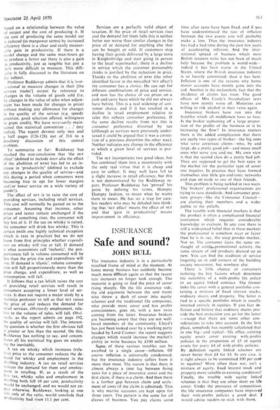INSURANCE
Safe and sound?
JOHN BULL
The insurance industry is in a particularly troubled frame of mind at the moment. At home motor, business has suddenly become much more itifficult again so that the recent rate increases no longer look enough. The motorist is going to find the price of cover rising sharply. On the life assurance side, the old argument between the unit trusts who throw a dash of cover into equity schemes and the traditional life companies, who provide more cover and less profits consciousness, goes on, with a new twist coming from the latter. Insurance brokers are becoming aware that they are not well- loved members of the community. Lloyd's has just been looked over by a working party headed by Lord Cromer: the report suggests changes which would increase the market's ability to write business by £100 million.
&Wile, of these various troubles can be ascribed to a single cause—inflation. Of course inflation is universally condemned, but the insurance industry suffers from it more than most. The reason is that there is almost always a time lag between fixing rates for a piece of insurance cover and the first claim, if there is a claim. And then there is a further gap between claim and settle- ment of costs (if the claim is admitted). This is why marine accounts are kept open for three years. The pattern is the same for all classes of business. You pay claims some
time after rates have been fixed, and if you have underestimated the rate of inflation between the two events you will probably make a loss. Thus the insurance industry has had a bad time during the past few years of accelerating inflation. And the inter- national spread of business which most British insurers write has not been of much help because the problem is world-wide— indeed it has been worse in the United States, where the British insurance industry is so heavily committed, than it has here. Inflation is one of the reasons why home motor accounts have mostly gone into the red. Another is the melancholy fact that the incidence of claims has risen. The good effects of Mrs Castle's breathalyser tests have now mostly worn off. Motorists are willing to risk alcohol in their veins again.
Insurance brokers have run into the troubles which all middlemen have to face. Is the broker syphoning off a large propor- tion of the profits of the business or is he increasing the flow? In insurance matters there is the added complication that there are really two types of broker—the big ones who serve corporate clients—who, by and large, do a pretty good job—and many small ones who serve you and me. My own view is that the second class do a pretty bad job. They are supposed to get the best rates in the market for the particular type of cover one requires. In practice they have formed themselves into little gin-and-tonic networks and pass on trade to one of their friends.
This problem is being tackled in two ways. The brokers' professional organisations are trying to raise standards. And consumer pres- sure groups—like the Consumer Council—. are alerting their members and a wider public to the pitfalls.
The trouble with financial markets is that the product is often a complicated financial instrument which requires considerable knowledge to evaluate. In any case there is still a widespread belief that in these markets the professional is somehow nicer or fairer than he is in, say, the soap powder market. Not so. The consumer faces the same on- slaught of costlywpromotional activity, the same stream of old products dressed up as new. You can find the tradition of service lingering on in odd corners of the building society movement, but nowhere else.
There is little chance of consumers isolating the key factors which determine the suitability of a with-profits life policy or an equity linked contract. The former links life cover with a general portfolio con- taining a mixture of fixed interest stocks, ordinary shares and property. The latter is tied to a specific portfolio which is usually invested entirely in equities. If you fear in- flation and believe that ordinary shares pro- vide the best protection you go for the latter —except that there are some other con- siderations to take into account. In the first place, somebody has recently calculated that in one big—and typical—life office, existing equity assets cover existing with-profits policies in the proportion of £5 of equity assets for every f4 of with-profits policies. By definition equity linked schemes are never better than f4 for £4. In any case. is it right always to be committed 100 per cent to equities? More often than not, isn't a mixture of equity, fixed interest stock and property more suitable to existing conditions?
Finally, the trouble with equity linked schemes is that they are often short on life cover. Under the pressures of competition, the life insurance companies have improved their with-profits policies a good deal. I would advise readers to stick with them.






































 Previous page
Previous page